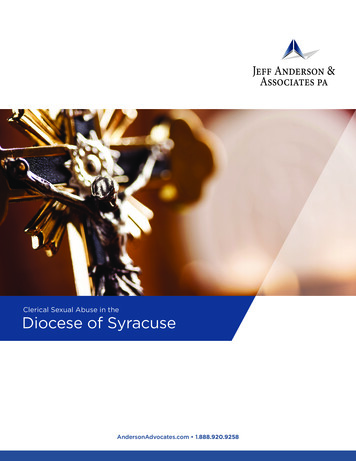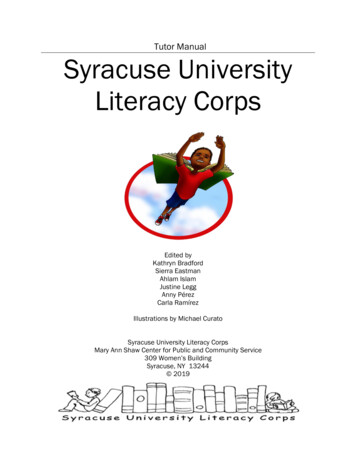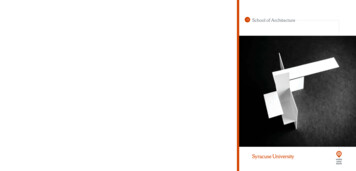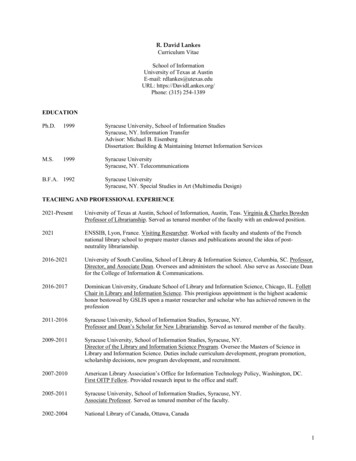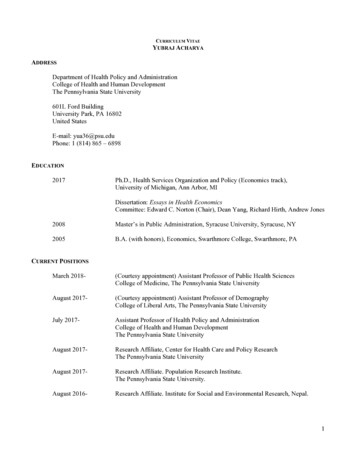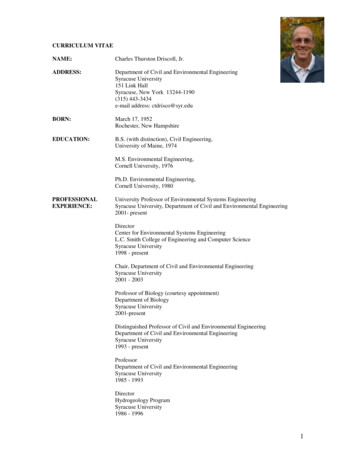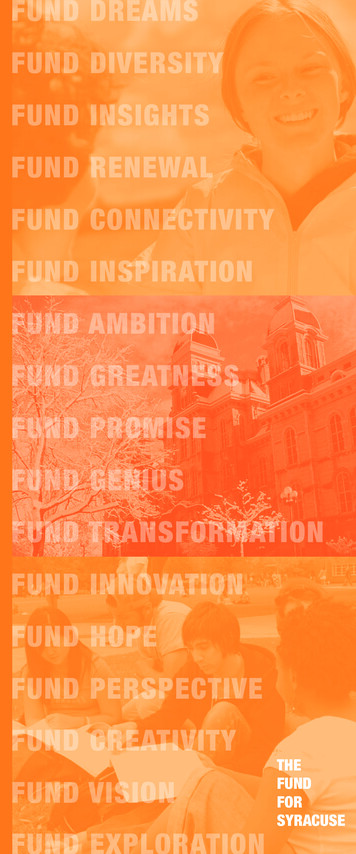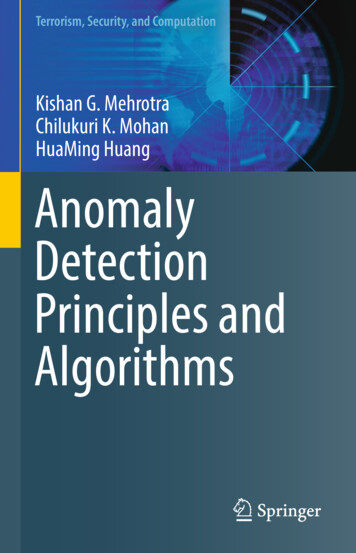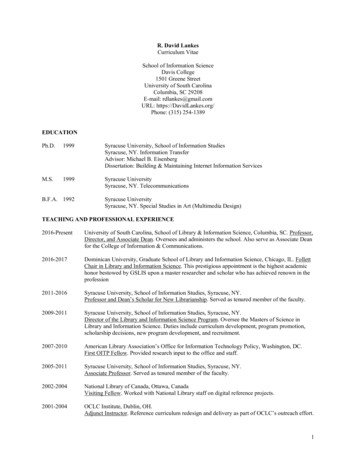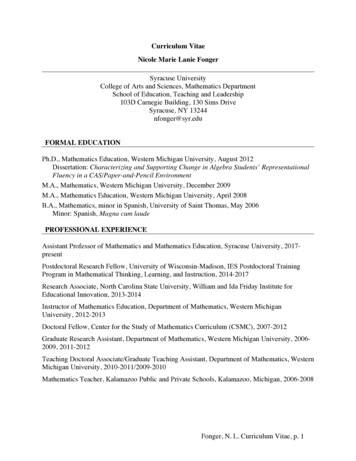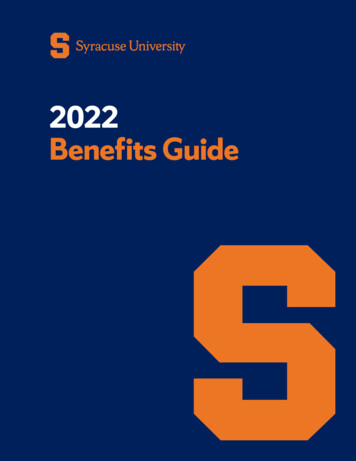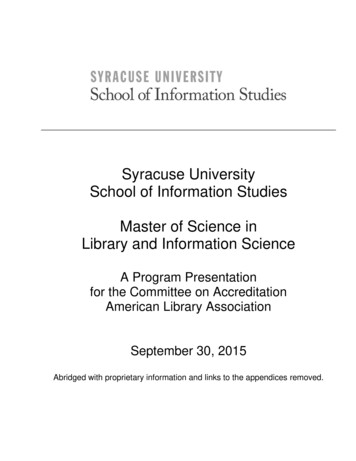
Transcription
Syracuse UniversitySchool of Information StudiesMaster of Science inLibrary and Information ScienceA Program Presentationfor the Committee on AccreditationAmerican Library AssociationSeptember 30, 2015Abridged with proprietary information and links to the appendices removed.
iSchool at Syracuse Universityii
SCHOOL OF INFORMATION STUDIESSYRACUSE UNIVERSITYREQUIRED INFORMATION:Unit organized and maintained for thepurpose of graduate education inlibrary and information studies:School of Information StudiesParent Institution:Syracuse UniversityChief Executive Officer, SyracuseUniversity:Kent Syverud, ChancellorChief Academic Officer, SyracuseUniversity:Elizabeth Liddy, Interim Provost andVice ChancellorPrinciple Administrator, School ofInformation Studies:Jeffrey Stanton, Interim DeanDegree Brought Forward for ReAccreditation:Master of Science in Library andInformation SciencePrinciple Administrator, Master ofScience in Library and InformationScience Program:Jill Hurst-Wahl, DirectorRegional Accrediting Agency andStatusSyracuse University is accredited bythe Middle States Association ofColleges and Secondary Schools,reaccredited in June 2008.Title and version of the Standardsaddressed in the ProgramPresentationStandards for Accreditation ofMaster’s Programs in Library andInformation Studies, 2008iSchool at Syracuse Universityi
iSchool at Syracuse Universityii
Brief Description of the Program Seeking AccreditationThe Syracuse University School of Information Studies offers the M.S. in Library andInformation Science (MSLIS) program, which is a 36-credit program. The program isgenerally completed in two to four years by students who are seeking to be prepared fortheir first position and those positions which follow after in academic, public, and speciallibraries, as well as other information environments. Those students seeking to work inthe K-12 environment complete the MSLIS with School Media Specialization (37-creditstotal). The MSLIS: School Media adheres to the certification requirements of the NewYork State Education Department.The MSLIS program at Syracuse University is one of seven MSLIS programs in NewYork State. The program has been continuously accredited since 1928/29. Its last reviewwas in 2008.The foundation of the MSLIS program at Syracuse University is comprised of its sevencore classes (19 credits) which cover these three areas: Introduction to the Profession Information Resources Management and PolicyThree of the core classes are shared across the graduate programs in the School ofInformation Studies, and students from the three programs take those classes together.Those classes are IST 601: Information & Information Environments, IST 614:Management Principles for Information Professionals, and IST 618: Information Policy.In addition, students take 14-15 credits of electives. All MSLIS students, unless theperson has in-depth library experience or is a school media student, complete a 150-hourinternship (3 credits). The MSLIS: School Media students take the same core classes asthe other LIS students and also take 15 credits of specific classes to complete theirspecialization. In addition, the MSLIS: School Media students are required to complete120 hours of practica experience both in elementary and secondary school settings.iSchool at Syracuse Universityiii
iSchool at Syracuse Universityiv
iSchool at Syracuse Universityv
iSchool at Syracuse Universityvi
SCHOOL OF INFORMATION STUDIESSYRACUSE UNIVERSITYACCREDITATION WORKING GROUPManager:Jill Hurst-Wahl, Director, MSLIS and MSLIS: School MediaiSchool Writing Team for Each Standard:Scott Nicholson and Megan OakleafJian Qin and Jill Hurst-WahlBarbara Kwasnik and Barbara StriplingMarilyn Arnone and R. David LankesStephen Block and Ruth SmallRenee Hill and Kenneth LavenderStandard I: Mission, Goals, and ObjectivesStandard II: CurriculumStandard III: FacultyStandard IV: StudentsStandard V: Administration & FinancialSupportStandard VI: Physical Support & FacilitiesAdditional Content Provided by:Eileen Allen, Research AdministratorKathleen Benjamin, Career Services Program CoordinatorBlythe Bennett, Manager, MSLIS and MSLIS: School MediaPeggy Takach, Director of Faculty Center for Teaching and LearningSheila Clifford-Bova, Faculty Support ManagerSusan Corieri, Assistant Dean for Enrollment ManagementSarah Hagelin, Assistant Dean for Student & Faculty Support ServicesEllen Hobbs, Senior AdministratorSarah Inoue, Post-Doctoral ResearcherRoger Merrill, Assistant Dean for IT Services and FacilitiesAnjali Parasnis-Samar, MSLIS expected ‘16Diane Stirling, Communications SpecialistJose Tavarez, Academic Advisor- GraduateVictoria Williams, Director of Online EducationiSchool at Syracuse Universityvii
Chapter Reviewers and Commenters: Stephanie Anderson, Head of Reader Services, Darien LibraryMatthew Casso, Jr., MSLIS expected ‘16, SU School of Information StudiesDebby Emerson, MLIS, Executive Director, Central NY Library Resources CouncilEmma Esperon, MSLIS ‘15, SU School of Information StudiesJeffrey Fouts, Director of Instructional TechnologyMartha Garcia-Murillo, Professor, School of Information StudiesChad Harper, MSLIS ‘15, SU School of Information StudiesCarl Haynes, MSLIS expected ‘16, SU School of Information StudiesJody K. Howard, PhD, Assoc. Professor, Darden College of Education, Old DominionUniversityAlexandra Heidler, MSLIS ‘15, SU School of Information StudiesDeanna King, MSLIS expected ‘16, SU School of Information StudiesBarbara Kwasnik, Professor, School of Information StudiesR. David Lankes, Professor, School of Information StudiesChristopher (Topher) Lawton, MSLIS, Science Reference Svcs. Librarian, Old DominionUniversityMary-Carol Lindbloom, MLS, Executive Director, South Central Regional LibraryCouncilDeborah Nosky, Director, B.S. in Info. Mgmt. and Technology, School of Info. StudiesKyra Nye, MSLIS ‘15, SU School of Information StudiesRyan Perry, MSLIS ‘15, SU School of Information StudiesBenjamin Poremski LIS Accreditation Assistant, University at BuffaloJared Raymond, MSLIS ‘15, SU School of Information StudiesDuncan Robak, MSLIS ‘15, SU School of Information StudiesPaul Signorelli, MLIS, Instructional Designer, Paul Signorelli & AssociatesPeggy Takach, Director of the Faculty Center for Teaching and LearningiSchool at Syracuse Universityviii
SCHOOL OF INFORMATION STUDIESSYRACUSE UNIVERSITYMASTER TABLE OF CONTENTSRequired Information . iBrief Description of the Program Seeking Accreditation . iiiDeclaration . vAccreditation Working Group . viiMaster Table of Contents . . ixAcronyms . xiSyracuse University and the MSLIS Program: An Introduction . 1Synthesis and Executive Summary . 11Chapter One: Mission, Goals, and Objectives . 27Standard I.1 . 29Standard I.2 . 37Standard I.2.1 . 37Standard I.2.2 . 38Standard I.2.3 . 38Standard I.2.4 . 39Standard I.2.5 . 39Standard I.2.6 . 41Standard I.2.7 . 41Standard I.2.8 . 42Standard I.2.9 . 42Standard I.2.10 . 43Standard I.3 . 44Chapter Two: Curriculum . 51Standard II.1 .53Standard II.2 .56Standard II.3 .59Standard II.4 .68Standard II.5 .71Standard II.6 .80iSchool at Syracuse Universityix
Standard II.7 .83Chapter Three: Faculty . 89Standard III.1 . 94Standard III.2. . 99Standard III.3 . 108Standard III.4 . 109Standard III.5 . 112Standard III.6 . 115Standard III.7 . 117Standard III.8 . 120Chapter Four: Students . 125Standard IV.1 . 129Standard IV.2. . 139Standard IV.3. . 140Standard IV.4 . 143Standard IV.5 . 148Standard IV.6 . 152Chapter Five: Administration and Financial Support . 161Standard V.1 . 163Standard V.2 . 166Standard V.3 . 170Standard V.4 . 172Standard V.5 . 174Standard V.6 . 178Standard V.7 . 178Standard V.8 . 181Chapter Six: Physical Resources and Facilities . 185Standard VI.1 .187Standard VI.2 .190Standard VI.3 .194Standard VI.4 .201Standard VI.5. .209iSchool at Syracuse Universityx
AppendixAppendix NameAppendix AiSchool Faculty Service Assignments 2009-2015Appendix BiSchool Board of Advisors 2008-2014Appendix CLIS Guiding Council Minutes 2014, 2015, Members, BylawsAppendix DSchool Media Governing Council Bylaws, Members, Minutes2013-2015Appendix EMSLIS Alumni Survey and Schedule of Future SurveysAppendix FReport on MSLIS Internship DataAppendix GOffice of Institutional Research and Assessment (OIRA) CourseEvaluation FormAppendix HCore Class Syllabi 2008-1014Appendix IiSchool Graduate Course DescriptionsAppendix JMSLIS Advising Guides and HandbooksAppendix KSample Independent StudiesAppendix LSample MSLIS Degree PlansAppendix MSample MSLIS InternshipsAppendix NMSLIS Core Course Rotation 2009-2015Appendix OWISE Principles of Quality Online CoursesAppendix PWISE Courses Offered to SU Students, SU Courses offered toWISE StudentsAppendix QMSLIS Faculty Program Advising Group (FPAG) Minutes 20082014Appendix RLIS Student Town Halls 2008-2015Appendix SReport of the MSLIS Curriculum Review Task ForceAppendix TiSchool Full Time Faculty 2014-2015Appendix USummary of iSchool Teaching Assignments Spring 2009-Fall2014iSchool at Syracuse Universityxi
Appendix ViSchool Faculty (Full Time, Part Time) Curriculum VitaeAppendix WFaculty Hire Interview Schedules (Semaan, Hemsley)Appendix XSchool of Information Studies Faculty Personnel Policies andProceduresAppendix YConferences & Workshops Attended by Faculty 2008-2015Appendix ZiSchool Research Centers and LaboratoriesAppendix AAiSchool Joint ProjectsAppendix BBMSLIS Faculty Service ActivitiesAppendix CCWorkshops Conducted by FacultyAppendix DDiSchool Faculty Conference Participation and PresentationsAppendix EEConference Exhibits Where LIS Programs Were FeaturedAppendix FFiSchool Faculty Committee Work, Professional Organizations,Juries, PanelsAppendix GGiSchool Faculty Funded ResearchAppendix HHPublications of MSLIS FPAG Members 2008-2014Appendix IIAdvanced Degrees Held by Full-Time FacultyAppendix JJPrint AdvertisementsAppendix KKProgram Guide 2014Appendix LLGraduate ScholarshipsAppendix MMMSLIS Internship GuidesAppendix NNMSLIS Student PlacementAppendix OOLibrary & Information Science Student Assembly (LISSA)Events 2014-2015Appendix PPLIS and School Media Convocation AwardsAppendix QQiSchool Organizational ChartiSchool at Syracuse Universityxii
Appendix RRiSchool Operating Sources and Uses of Funds Fiscal Year 2014Appendix SSiSchool Travel Reimbursement PolicyAppendix TTHinds Hall Floor Plan 2015Appendix UUStatus of Blackboard Outcomes AssessmentAppendix VVMSLIS Sample Student WorkAppendix WWiSchool Adjunct Faculty and CompetenciesAppendix XXSchool Media Competency ChecklistAppendix YYMSLIS Elective Survey ResultsAppendix ZZiSchool Faculty Position AdvertisementsAppendix AAAiSchool Faculty Meeting MinutesAppendix BBBPartial Listing of Student Events at the iSchool Fall 2014Appendix CCCMSLIS Faculty Teaching Awards and HonorsAppendix DDDiSchool Course Evaluation DataAppendix EEEMSLIS Employer Survey ResultsAppendix FFFSyracuse University Course Proposal FormAppendix GGGiSchool New Course ProposalsAppendix HHHSyllabus TemplateAppendix IIICertificate of Advanced Studies Course MatrixAppendix JJJApplication FormAppendix KKKProcess for Curriculum Approval and ChangeAppendix LLLStudent Course EnrollmentAppendix MMMSyracuse University Academic Strategic PlaniSchool at Syracuse Universityxiii
iSchool at Syracuse Universityxiv
ACRONYMS3DThree-dimensionalADAAAssociate Dean for Academic AffairsAASLAmerican Association of School LibrariansACRLAssociation of College and Research LibrariesADAAmericans with Disabilities ActALAAmerican Library AssociationALISEAssociation for Library and Information Science EducationARLAssociation of Research LibrariesASIS&TAmerican Society for Information Science and TechnologyBLISTSBlack and Latino Information Studies SupportBOOSTBolstering Original Opportunity and Self through TechnologyBSBachelor of ScienceCAEPCouncil for the Accreditation of Educator PreparationCASCertificate of Advanced StudyCAS CHPCertificate of Advanced Study in Cultural Heritage PreservationCAS DLCertificate of Advanced Study in Digital LibrariesCAS DSCertificate of Advanced Study in Data ScienceCDCompact discCDLCenter for Digital LiteracyCCENTCenter for Convergent and Emerging Network TechnologiesCNLPCenter for Natural Language ProcessingCOACommittee on AccreditationCRMConstituent Relationship Management (CRM)DASADignity for All Students ActDCMIDublin Core Metadata InitiativeDVDDigital versatile discELEmerging Leaders (ALA program)ENABLEExpanding Nondiscriminatory Access by Librarians EverywhereERICEducation Resources Information CenterFCTLFaculty Center for Teaching and LearningFiTSFilling in the SpacesiSchool at Syracuse Universityxv
FTEFull-time equivalentFPAGFaculty Program Advisory GroupGDCGreen Data CenterGETGlobal Enterprise TechnologyGPAGrade point averageGREGraduate Record ExaminationsHDHigh-definitionHTMLHypertext markup languageICEInnovation, Collaboration and Entrepreneurship (ICE Box)IELTSInternational English Language Testing SystemIFLAInternational Federation of Library AssociationsiLMSiSchool Learning Management SystemIMInformation ManagementIM&TInformation Management & TechnologyIMLSInstitute of Museum and Library ServicesiSchoolSchool of Information Studies (at Syracuse University)ISTDepartment prefix for courses offered by SU’s School of Information StudiesiSGOiSchool Graduate Student OrganizationITInformation TechnologyITELLInformation Technology Experiential Learning LabITSInformation and Technology Services (of Syracuse University)JCLCJoint Conference for Librarians of ColorLCDLiquid crystal displayLEDLight-emitting diodeLEMPLearning Environments and Media ProductionsLGBTQLesbian, Gay, Bisexual, Trans and QueerLISLibrary and Information ScienceLIS:SMLibrary and Information Science: School MediaLISSALibrary and Information Science Student AssemblyLMSLearning Management SystemMARCMachine-readable catalogingMLAMedical Library AssociationiSchool at Syracuse Universityxvi
MLSMaster of Library ScienceMSLISMaster of Science in Library and Information ScienceMSLIS: SMMaster of Science in Library and Information Science: School MediaMOOCMassive Open Online CourseNASANational Aeronautics and Space AgencyNASKONorth American Symposium on Knowledge OrganizationNCATENational Council for Accreditation of Teacher EducationNCSUNorth Carolina State UniversityNELANew England Library AssociationNEXISNew Explorations in Information and ScienceNLPNatural language processingNSDLNational Science Digital LibraryNSFNational Science FoundationNYLANew York Library AssociationNYSEDNew York State Education DepartmentOCLCOnline Computer Library CenterOCPLOnondaga County Public LibraryOITPOffice for Information Technology Policy (of ALA)OPACOnline public access catalogPLUSPreparing Librarians for Urban SchoolsPLUS-NYPreparing Librarians for Urban Schools – New YorkR&DResearch and developmentRCMResponsibility Center ManagementSCALEStanford Center for Assessment, Learning and EquitySEOSearch engine optimizationSFDSenior faculty developmentSISSystems and Information ScienceSLASpecial Libraries AssociationSMSchool MediaSUSyracuse UniversitySUNY-ESFState University of New York College of Environmental Science and ForestryTNMTelecommunications and network managementiSchool at Syracuse Universityxvii
TOEFLTest of English as a Foreign LanguageUAACUniversity Assessment and Accreditation CommitteeVHEVirtual Hosting EnvironmentVPAVisual and Performing ArtsVPUVideo production unitWISEWeb-based Information Science EducationXMLExtensible markup languageiSchool at Syracuse Universityxviii
Syracuse University and the Master of Science in Library andInformation Science Program: An IntroductionNo Master Degree program in Library and Information Science (MSLIS) exists in a vacuum.Certainly, societal trends impact the priorities and practices of the information profession andtherefore, the curriculum, pedagogy, and student population of an MSLIS program.Likewise, every MSLIS program also is part of a larger academic institution, and therefore isinfluenced by that institution’s environment, leadership, and priorities. The Syracuse MSLISprogram is further impacted by the fact that it is part of the School of Information Studies(iSchool), one of 13 academic units at Syracuse University.Although the iSchool is the smallest school/college at Syracuse (SU), it is known for beingforward-thinking, innovative, and fast-moving, traits that quickly are becoming adopted by theentire University in its efforts to retool for a more pertinent and prosperous future. The cultureexhibited at the iSchool is one where opportunities and areas for improvement are recognizedand then are quickly addressed.In the last seven years, Syracuse University has witnessed many societal changes, including anumber that have put pressures on most universities and colleges. For example, the GreatRecession brought more students to higher education, who felt that a college education orgraduate school degree would help with their career aspirations.1With their enrollment, colleges and universities then had to manage the increased size of classesand additional pressures on other aspects of their infrastructures (e.g., the number of dormitoryrooms) over the last few years. Nearly simultaneously though, the demographic trend of fewernumbers of 18-year-olds in the United States has meant that colleges and universities are vyingover a shrinking pool2 of incoming students, even though a larger percentage of that pool isattending college.These societal issues have framed the academic environment of Syracuse University. Foundedin 1870 and chartered by the New York State Board of Regents, Syracuse University is ananchor institution in the city of Syracuse and is respected across the region and the United States.Total University enrollment for Fall 2014 was 21,492, including 6,268 full- and part-timegraduate and law-school students.3 As of Fall 2014, the University had 1,678 faculty members,Katherine Mangan. “Colleges Saw a Flood of Students at Recession’s Peak—and Discouraging Results.”Chronicle of Higher Education. No 18, 2014. of/150111/2William J. Hussar and Tabitha M. Bailey. Projections of Education Statistics to ding to the Syracuse University Diagnostic Report, from 2008-2012, undergraduate and graduate enrollmenthas had a Compounded Annual Growth Rate (CAGR) of 4.3 percent. Bain & Co. Syracuse University DiagnosticReport, April 2014. http://syr.edu/news/articles/Innovation and Opportunities Assessment Report.pdf1iSchool at Syracuse University1
with 68 percent being full-time tenure-track or non-tenure track faculty, and 89 percent havingearned a Ph.D. or professional degree.Syracuse University has responded to the societal pressures on the academe, and concurrentlyhas taken into account the changing demographic and economic realities of the times. At thesame time, the university has experienced the departure of one Chancellor and the arrival ofanother. The differing perspectives of the two leaders—one externally focused in the communityand globally; the other keen on planning, assessment, and robust internal operations—has led toa period of transition that has impacted the entire university. While change is expected during aleadership transition, all corners of the campus have undergone a period of swift, concurrent, andfar-seeing change since the new Chancellor took the reins in 2014.2004-2013: Chancellor Nancy CantorDr. Nancy Cantor led Syracuse University as Chancellor from 2004-2013. During that time, shehad three primary areas of focus, all of which influenced the campus and community, includingthe iSchool. Her main theme for the University was “Scholarship in Action,” an initiative “inwhich students and faculty engaged in collaborative public and interdisciplinary scholarship thatsimultaneously addressed real-world needs while advancing knowledge.”She demonstrated that idea through physical and educational outreach to areas of the City ofSyracuse known as the Southside and the Near Westside, with projects aimed at improving ourrust-belt city. They included:- Syracuse Entrepreneurial Ecosystem Development (SEED), which developedtechnologies to support a prototype of an urban farm and the technologies and businessesthat go along with urban farming- Smart Kids: Visual Stories, in which students at local schools made videos about theirschools as part of the conversation on the needs of urban school districts- Say Yes to Education, in which local colleges and universities provided scholarships tocollege for all qualifying students in the Syracuse City School District—making collegeattainable and accessible to the community, no matter individuals’ socio-economic status.These projects also reflected her second area of focus, the idea of universities as anchorinstitutions in their communities, and she invested time, energy and funding in the universitybecoming a full and generous partner to the region.Cantor also strived to make a university education more accessible to everyone. She changedadmission policies to further this goal and increased the diversity of SU students in terms ofculture, ethnicity, and socio-economic status. During her tenure, the number of students at SUgrew, both due to the efforts of the university and the increased number of adults seeking acollege education. During that time, the university also financed several new buildings oncampus, created new scholarships for disadvantaged populations, and made other investments toexpand its academic reach.iSchool at Syracuse University2
2014-Present: Chancellor Kent SyverudSyracuse University came under new leadership in 2014, when Dr. Kent Syverud wasinaugurated as Chancellor.The transition to Chancellor Syverud has been represented by many new areas of focus. Theyinclude new planning and administrative rigor, several physical-space and infrastructureinitiatives, and a counterbalancing of views towards operations and resource use. ChancellorSyverud signaled some new directions for SU in his inaugural address, and since then has takensteps to make sure the university can be its best self.In his initial statement to the University community, Chancellor Syverud discussed the issue of adiverse student body, stating, “We want those who are hungry for knowledge,” and clarified theconcept of the “unentitled ” those who let merit, not birth state, define who they are. He alsoacknowledged the need to pay attention to rankings and to improve the University bystrengthening its focus on scholarly research. The Chancellor has consistently asked theUniversity community to “Aim High and Aim Carefully.”After his inauguration, Syverud established the Fast Forward Syracuse initiative to focus on arange of changes and improvements that already have begun to take place under his tenure. FastForward Syracuse has three focus areas: Academic Strategic Plan, which is the most important area of focus, and sets out the visionand goals of the University as well as creates a path forward. The working group for theAcademic Strategic Plan has sought input from faculty, staff and students on new missionand vision statements for the University. Additionally, the working group is proposing sixpriority areas, which are outlined in a draft of the plan:4o The student experienceo Discoveryo Internationalizationo Veterans Affairso Innovationo One University Operational Excellence, which seeks to determine how we can improve the logistics ofrunning a university. Operational Excellence acknowledges the need to face challenges ineffectively allocating resources, controlling rising costs, and modernizing systems andprocesses. Campus Master Plan, which seeks to improve the campus’ physical infrastructure based oncurrent and projected needs. While the campus has indeed grown and changed since 1870when SU was founded, no one has recently taken a holistic look at the physical infrastructureand determined what improvements are truly needed. Once adopted, the Campus MasterAcademic Strategic Plan Draft, April 2015. /04/
iSchool at Syracuse University iii Brief Description of the Program Seeking Accreditation The Syracuse University School of Information Studies offers the M.S. in Library and Information Science (MSLIS) program, which is a 36-credit program. The program is generally completed in two to four years by students who are seeking to be prepared for
